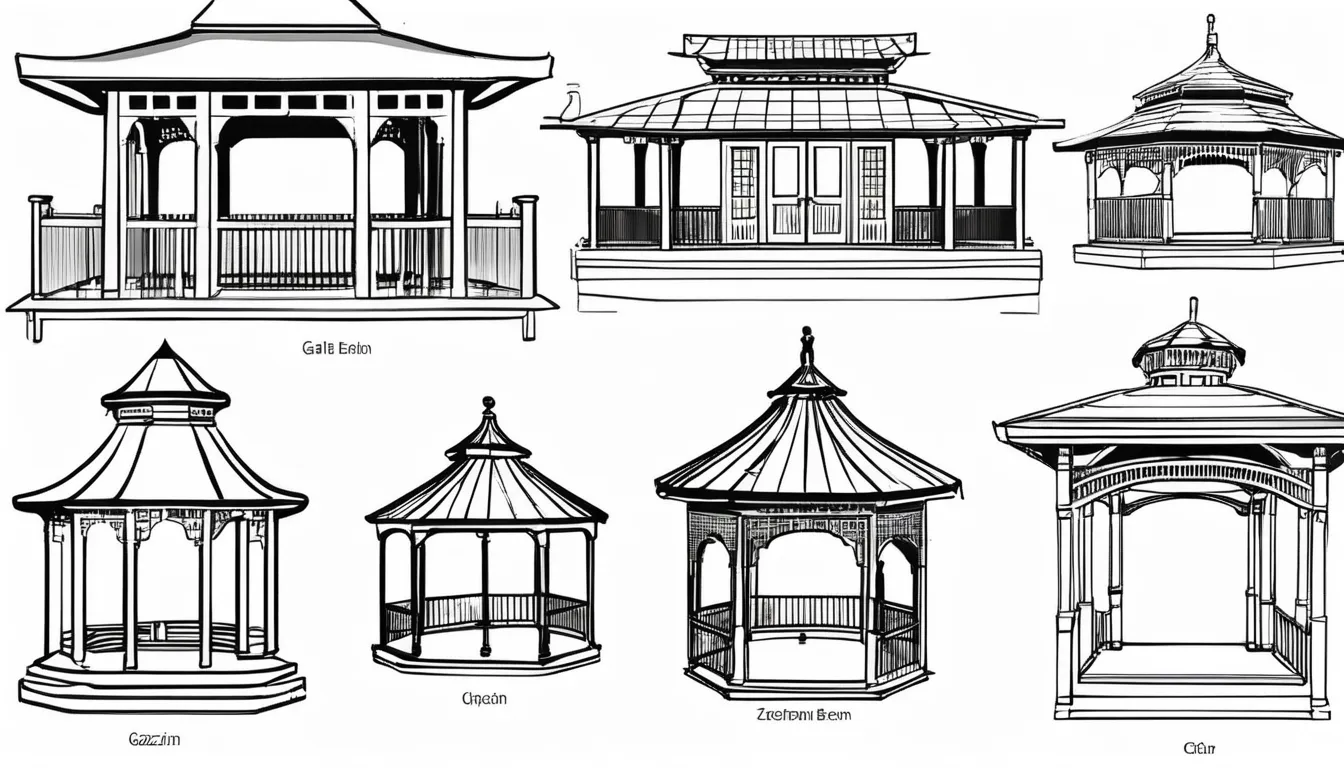When you think about enhancing your outdoor space, you might find yourself torn between a pagoda, pergola, or gazebo. Each structure brings its own unique charm and functionality, but understanding their key differences can help you make an informed choice. Pagodas offer intricate designs often tied to cultural significance, while pergolas create airy, shaded areas for relaxation. Gazebos, on the other hand, provide a more enclosed retreat for gatherings. As you consider these options, you might wonder which one aligns best with your needs and aesthetic preferences…
Definition of Each Structure
When considering outdoor structures, it’s essential to understand their unique definitions.
A pagoda is a tiered tower often found in East Asian architecture, characterized by its multiple roofs and ornate designs. It’s typically made from wood or stone and serves both religious and cultural purposes, providing a serene space for contemplation.
On the other hand, a pergola is a more open structure, usually featuring a series of vertical posts or columns that support a grid of beams and rafters.
You might place it in your garden to create a shaded walkway or passageway, making it perfect for climbing plants to flourish. It offers a blend of sun and shade, ideal for outdoor gatherings.
Design and Aesthetic Features
Each of these outdoor structures showcases distinct design and aesthetic features that cater to various tastes and purposes.
A pagoda often features tiered roofs, intricate carvings, and ornate details that reflect Asian architectural styles. This design creates a serene, cultural atmosphere, making it perfect for gardens or meditation spaces.
On the other hand, a pergola boasts an open framework, usually with vertical posts and crossbeams, allowing for a more casual and airy feel. You can climb vines or hang lights to enhance its charm, making it ideal for outdoor dining or lounging areas. Its simplicity complements various landscape designs.
A gazebo, typically round or octagonal, offers a more enclosed space with a solid roof and often features railings or decorative trim. Its structure provides a cozy retreat, perfect for intimate gatherings, and its design can range from rustic wooden styles to elegant wrought iron.
Ultimately, your choice among these structures will depend on your aesthetic preference and the mood you want to create in your outdoor space. Each brings its unique flair, enriching your garden or patio in different ways.
Functional Purposes and Uses
In choosing between a gazebo price comparison , pergola, or gazebo, understanding their functional purposes can help you make the best decision for your outdoor space. Each structure serves unique functions that can enhance your outdoor experience.
A pagoda typically offers a serene and ornamental space, perfect for meditation or enjoying nature. Its elevated design often makes it a focal point in gardens, inviting you to relax and take in your surroundings.
On the other hand, a pergola provides partial shelter, creating an ideal area for outdoor dining or entertaining. Its open design allows for sunlight while still offering some shade, making it a versatile option for gatherings or barbecues.
You can easily train climbing plants on it, adding to its charm.
A gazebo, with its enclosed structure, serves as a more private retreat. It’s great for hosting small parties, enjoying a quiet afternoon, or even using it as a play area for kids.
Its solid roof protects you from the elements, ensuring comfort year-round.
Material and Construction Options
Choosing the right material and construction for your pagoda, pergola, or gazebo can significantly impact its durability and aesthetic appeal. Each structure offers various options that cater to your style and local climate.
For instance, wood is a classic choice, providing warmth and charm, but requires regular maintenance. Alternatively, metal options like aluminum or wrought iron offer sturdiness and longevity with less upkeep. You might also consider vinyl for a low-maintenance yet attractive solution.
Here’s a quick comparison of materials:
| Structure | Material Options | Aesthetic Appeal |
|---|---|---|
| Pagoda | Wood, Stone, Metal | Traditional, Elegant |
| Pergola | Wood, Aluminum, Vinyl | Rustic, Modern |
| Gazebo | Wood, Metal, Vinyl | Cozy, Inviting |
Cost and Maintenance Considerations
When it comes to cost and maintenance, understanding the long-term investment for your pagoda, pergola, or gazebo is crucial. Each structure varies significantly in both initial costs and ongoing upkeep.
Generally, pagodas tend to be the most expensive, often requiring specialized materials and craftsmanship. If you’re looking for something more budget-friendly, pergolas usually have a lower price tag, especially if you opt for wood or vinyl. Gazebos fall somewhere in between, with cost heavily influenced by size and materials.
Maintenance is another key factor. Pagodas often need more attention, as their intricate designs can trap debris and require regular cleaning and repairs.
Pergolas are relatively easy to maintain, needing occasional staining or sealing to protect against the elements. Gazebos, depending on the material, may require periodic upkeep, like repainting or re-staining.
Ultimately, consider your budget and the time you’re willing to invest in maintenance. Choosing the right structure involves weighing initial costs against long-term care to ensure you’re satisfied with your outdoor investment for years to come.
Conclusion
In summary, when choosing between a pagoda, pergola, or gazebo, consider your specific needs and preferences. Pagodas add cultural flair, pergolas create lovely shaded spaces for plants, and gazebos offer cozy retreats for gatherings. Each structure has its unique charm and functionality, so think about the design, purpose, and maintenance requirements that suit your outdoor space best. Ultimately, the right choice will enhance your environment and provide a perfect spot for relaxation and enjoyment.



